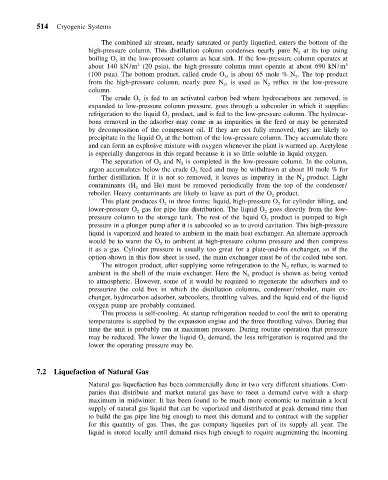Page 525 - Mechanical Engineers' Handbook (Volume 4)
P. 525
514 Cryogenic Systems
The combined air stream, nearly saturated or partly liquefied, enters the bottom of the
high-pressure column. This distillation column condenses nearly pure N at its top using
2
boiling O in the low-pressure column as heat sink. If the low-pressure column operates at
2
2
about 140 kN/m (20 psia), the high-pressure column must operate at about 690 kN/m 2
(100 psia). The bottom product, called crude O , is about 65 mole % N . The top product
2
2
from the high-pressure column, nearly pure N , is used as N reflux in the low-pressure
2
2
column.
The crude O is fed to an activated carbon bed where hydrocarbons are removed, is
2
expanded to low-pressure column pressure, goes through a subcooler in which it supplies
refrigeration to the liquid O product, and is fed to the low-pressure column. The hydrocar-
2
bons removed in the adsorber may come in as impurities in the feed or may be generated
by decomposition of the compressor oil. If they are not fully removed, they are likely to
precipitate in the liquid O at the bottom of the low-pressure column. They accumulate there
2
and can form an explosive mixture with oxygen whenever the plant is warmed up. Acetylene
is especially dangerous in this regard because it is so little soluble in liquid oxygen.
The separation of O and N is completed in the low-pressure column. In the column,
2
2
argon accumulates below the crude O feed and may be withdrawn at about 10 mole % for
2
further distillation. If it is not so removed, it leaves as impurity in the N product. Light
2
contaminants (H and He) must be removed periodically from the top of the condenser/
2
product.
reboiler. Heavy contaminants are likely to leave as part of the O 2
in three forms: liquid, high-pressure O for cylinder filling, and
This plant produces O 2 2
lower-pressure O gas for pipe line distribution. The liquid O goes directly from the low-
2
2
product is pumped to high
pressure column to the storage tank. The rest of the liquid O 2
pressure in a plunger pump after it is subcooled so as to avoid cavitation. This high-pressure
liquid is vaporized and heated to ambient in the main heat exchanger. An alternate approach
to ambient at high-pressure column pressure and then compress
would be to warm the O 2
it as a gas. Cylinder pressure is usually too great for a plate-and-fin exchanger, so if the
option shown in this flow sheet is used, the main exchanger must be of the coiled tube sort.
reflux, is warmed to
The nitrogen product, after supplying some refrigeration to the N 2
product is shown as being vented
ambient in the shell of the main exchanger. Here the N 2
to atmospheric. However, some of it would be required to regenerate the adsorbers and to
pressurize the cold box in which the distillation columns, condenser/reboiler, main ex-
changer, hydrocarbon adsorber, subcoolers, throttling valves, and the liquid end of the liquid
oxygen pump are probably contained.
This process is self-cooling. At startup refrigeration needed to cool the unit to operating
temperatures is supplied by the expansion engine and the three throttling valves. During that
time the unit is probably run at maximum pressure. During routine operation that pressure
demand, the less refrigeration is required and the
may be reduced. The lower the liquid O 2
lower the operating pressure may be.
7.2 Liquefaction of Natural Gas
Natural gas liquefaction has been commercially done in two very different situations. Com-
panies that distribute and market natural gas have to meet a demand curve with a sharp
maximum in midwinter. It has been found to be much more economic to maintain a local
supply of natural gas liquid that can be vaporized and distributed at peak demand time than
to build the gas pipe line big enough to meet this demand and to contract with the supplier
for this quantity of gas. Thus, the gas company liquefies part of its supply all year. The
liquid is stored locally until demand rises high enough to require augmenting the incoming

